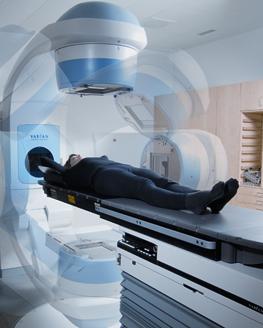|
BRACHYTHERAPY
Also known as internal radiation, brachytherapy involves placing radioactive material into a tumor or its surrounding tissue. Because the radiation
sources are placed so close to the tumor, your radiation oncologist can deliver a large dose of radiation directly to the cancer cells. The radioactive sources used in brachytherapy, such as thin wires, ribbons, capsules or seeds, come in small sealed containers. These sources may be implanted permanently or temporarily. A permanent implant remains in the body after the sources are no longer radioactive. Other radioactive sources are placed temporarily inside the body and are removed after the right amount of radiation has been delivered.
CHEMOTHERAPY
Medicines prescribed by a medical oncologist that can kill cancer cells directly are called chemotherapy. Some are given in pill form, and some are given by injection. Chemotherapy can also be considered a type of systemic therapy, because medicines go through the bloodstream to the entire body. |
|
 |
|
EXTERNAL BEAM RADIATION THERAPY
During external beam radiation therapy, a beam of radiation is directed through the skin to the cancer and the immediate surrounding area in order to destroy the main tumor and any nearby cancer cells. To minimize side effects, the treatments are typically given five days a week, Monday through Friday, for a number of weeks. This allows doctors to get enough radiation into the body to kill the cancer while giving healthy cells time each day to recover. The radiation beam is usually generated by a machine called a linear accelerator. The linear accelerator, or linac, is capable
of producing high-energy X-rays and electrons for the treatment of your cancer. Using high-tech treatment planning software, your treatment team controls the size and shape of the beam, as well as how it is directed at your body, to effectively treat your tumor while sparing the surrounding normal tissue. Several special types of external beam therapy are discussed in the next sections. These are used for specific types of cancer, and your radiation oncologist will recommend one of these treatments if he or she believes it will help you.
IMMUNOTHERAPY
Some treatments are designed to help your own body’s immune system fight the cancer, similar to how your body fights off infections. INTENSITY MODULATED RADIATION THERAPY (IMRT)
Intensity modulated radiation therapy, or IMRT, is a specialized form of 3DCRT that allows radiation to be more exactly shaped to fit the tumor. With IMRT, the radiation beam can be broken up into many “beamlets,” and the intensity of each beamlet can be adjusted individually. Using IMRT, it may be possible to further limit the amount of radiation that is received by healthy tissue near the tumor. In some situations, this may also allow a higher dose of radiation to be delivered to the tumor, potentially increasing the chance of a cure.

|
|
